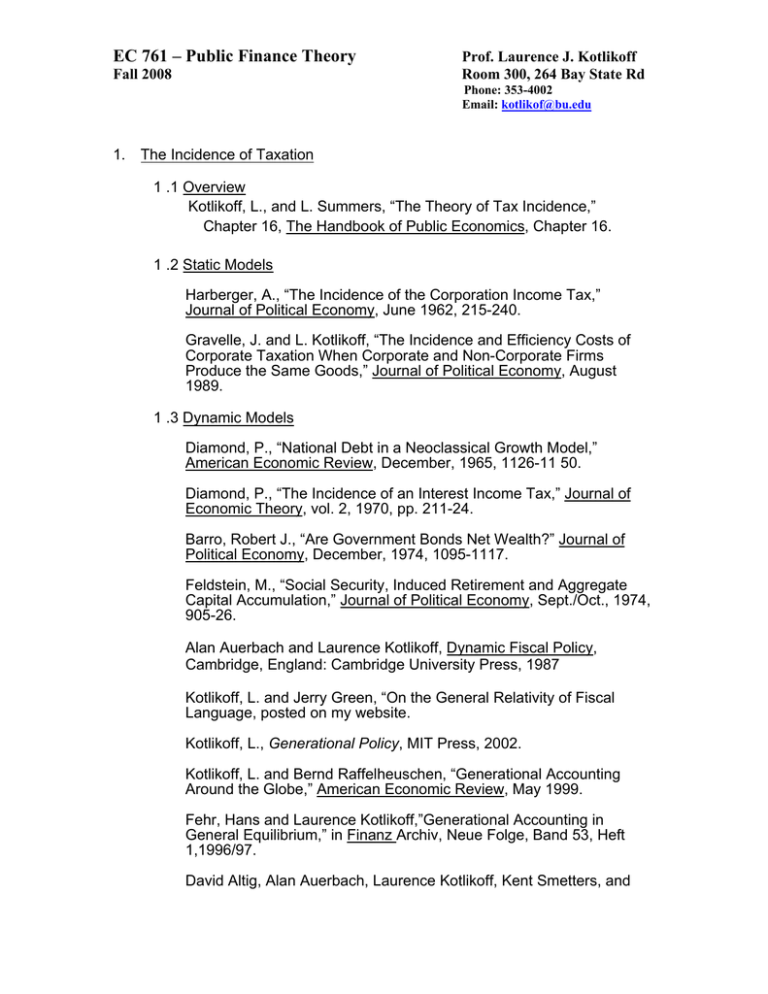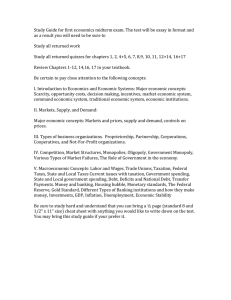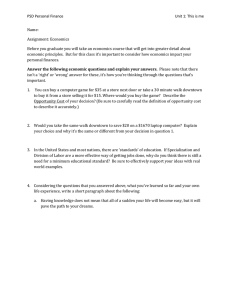EC 761 – Public Finance Theory
advertisement

EC 761 – Public Finance Theory Fall 2008 Prof. Laurence J. Kotlikoff Room 300, 264 Bay State Rd Phone: 353-4002 Email: kotlikof@bu.edu 1. The Incidence of Taxation 1 .1 Overview Kotlikoff, L., and L. Summers, “The Theory of Tax Incidence,” Chapter 16, The Handbook of Public Economics, Chapter 16. 1 .2 Static Models Harberger, A., “The Incidence of the Corporation Income Tax,” Journal of Political Economy, June 1962, 215-240. Gravelle, J. and L. Kotlikoff, “The Incidence and Efficiency Costs of Corporate Taxation When Corporate and Non-Corporate Firms Produce the Same Goods,” Journal of Political Economy, August 1989. 1 .3 Dynamic Models Diamond, P., “National Debt in a Neoclassical Growth Model,” American Economic Review, December, 1965, 1126-11 50. Diamond, P., “The Incidence of an Interest Income Tax,” Journal of Economic Theory, vol. 2, 1970, pp. 211-24. Barro, Robert J., “Are Government Bonds Net Wealth?” Journal of Political Economy, December, 1974, 1095-1117. Feldstein, M., “Social Security, Induced Retirement and Aggregate Capital Accumulation,” Journal of Political Economy, Sept./Oct., 1974, 905-26. Alan Auerbach and Laurence Kotlikoff, Dynamic Fiscal Policy, Cambridge, England: Cambridge University Press, 1987 Kotlikoff, L. and Jerry Green, “On the General Relativity of Fiscal Language, posted on my website. Kotlikoff, L., Generational Policy, MIT Press, 2002. Kotlikoff, L. and Bernd Raffelheuschen, “Generational Accounting Around the Globe,” American Economic Review, May 1999. Fehr, Hans and Laurence Kotlikoff,”Generational Accounting in General Equilibrium,” in Finanz Archiv, Neue Folge, Band 53, Heft 1,1996/97. David Altig, Alan Auerbach, Laurence Kotlikoff, Kent Smetters, and EC 761 – Public Finance Theory Fall 2008 page 2 Jan Walliser, “Simulating U.S. Tax Reform,” NBER working paper no. 6248, October 1997. Cutler, David, “Tax Reform and the Stock Market: An Asset Price Approach,” American Economic Review, 78, December 1988, 11071117. Will China Eat Our Lunch or Take Us to Dinner? – Simulating the Transition Paths of the U.S., EU, Japan, and China (with Hans Fehr and Sabine Jokisch), March 2007. Posted on my website. Jonathan Gruber and Botond Koszegi, “Tax Incidence When Individuals are Time-Inconsistent: The Case of Cigarette Excise Taxes,” Journal of Public Economics, August 2004, pp. 1959-1987. www.sciencedirect.com Roger Gordon and James Hines, “International Taxation,” Handbook of Public Economics, vol. 4, Chapter 28. www.sciencedirect.com 1.4 Dynamic Models with Asset Markets Feldstein, M., “The Surprising Incidence of a Tax on Pure Rent: A New Answer to an Old Question,” Journal of Political Economy, vol. 85,1977, pp. 349-60. Calvo, G., C. Rodriquez, and L. Kotlikofff, “The Incidence of a Tax on Pure Rent: A New Reason for an Old Answer,” Journal of Political Economy, August 1979. Summers, L., “Taxation and Corporate Investment: A q Theory Approach,” Brookings Papers on Economic Activity, Spring 1981. Chamley, C. and B. Wright, “Fiscal Incidence in an Overlapping Generations Model with a Fixed Asset,” Journal of Public Economics. vol. 32, February 1987, pp. 3-24. Auerbach, A., “Wealth Maximization and the Cost of Capital,” Quarterly Journal of Economics, August 1979. Alan Auerbach, “Taxation and Corporate Financial Policy,” Handbook of Public Economics, vol. 3, Chapter 19. www.sciencedirect.com 1 .5 Models with Endogenous Growth Stokey, Nancy and Sergio Rebelo, “Growth Effects of Flat-Rate Taxes,” Journal of Political Economy, june 1995, 519-50. Chamley, Christophe, “Fiscal Policy and Endogenous Growth: EC 761 – Public Finance Theory Fall 2008 page 3 Anything New?”, Draft, Boston University, 1992. 1 .6 Imperfect Competition and Incidence Atkinson, A. and J. Stiglitz, Lectures in Public Economics, Chapter 7. Katz, M. and H. Rosen, “Tax Analysis in an Oligopoly Model,” Public Finance Quarterly, January 1985. C. Davidson and L. Martin, “General Equilibrium Tax Incidence Under Imperfect Competition: A Quantity-Setting Supergame Analysis,”Journal of Political Economy, December 1985. Kotlikoff, L. and S. Pinera, “The Old South’s Stake in the InterRegional Movement of Slaves, 1850-1860,” The Journal of Economic History, vol. 37, June 1977. H. Konishi, M. Okuno-Fujiwara, and K. Suzumura, “Oligopolisitic Competition and Economic Welfare,” Journal of Public Economics, August 1990. 2. Efficiency Aspects of Taxation 2.1 The Theory of Excess Burden Diamond, P. and D. McFadden, “Some Uses of the Expenditure Function in Public Finance,” Journal of Public Economics, February, 1974, 3-21. Atkinson, A. and J. Stiglitz, Lectures in Public Economics, Chapters 12, 14-5, 15-1, 2, 3. Auerbach, A., “The Theory of Excess Burden and Optimal Taxation,” Chapter 1, the Handbook of Public Economics. Krueger, A., “The Political Economy of the Rent-Seeking Society,” American Economic Review, 64, June 1974, 291-303. Becker, G., “A Theory of Competition Among Pressure Groups for Political Influence,” Quarterly Journal of Economics, 1983. 2.2 The Theory of Optimal Taxation Auerbach, A., “The Theory of Excess Burden,” the Handbook of Public Economics, Sections 5 to 8. Auerbach and Hines, “Taxation and Economic Efficiency,” Handbook of Public Economics, vol. 3, Chapter 21; Sections 5 and 6. EC 761 – Public Finance Theory Fall 2008 page 4 www.sciencedirect.com Sandmo, A., “Optimal Taxation: An Introduction to the Literature, Journal of Public Economics, July, 1976, 37-54. Chamley, Christophe, “Optimal Taxation of Capital Income in General Equilibrium with Infinite Lives,” Econometrica, May 1986, 607-22. Stern, N. “The Theory of Optimal Commodity and Income Taxation: An Introduction,” in D. Newberry and N. Stern, The Theory of Taxation in Developing Countries, (Oxford: Oxford University Press,1987), pp. 22-59 Diamond, P. and J. Mirrless, “Optimal Taxation and Public Production,” American Economic Review, March and June 1971. Bruce, N. and M. Waldman, “Transfers in Kind: Why they Can Be Efficient and Nonpaternalistic,” American Economic Review, December 1 991. Feldstein, Martin and David Hartman, “The Optimal Taxation of Foreign-Source Investment,” Quarterly Journal of Economics, November 1979, 613-29. Rachel Griffith and Alexander Klemm, “What Has Been the Tax Competition Experience of the Last 20 Years?” Institute for Fiscal Studies Working Paper 04/05, February 2004. www.ifs.org.uk Aspen Gorry and Ezra Oberfield, “Optimal Taxation over the Life Cycle”, University of Chicago, August 25, 2008. 2.3 Time Consistency Problems and Third Best Taxation Fischer, S., “Dynamic Inconsistency, Co-Operation, and the Benevolent Dissembling Government,” Journal of Economic Dynamics and Control, 1980. Kotlikoff, L., Perrson, T., and L. Svenson, “Laws as Assets: A Possible Solution to the Time Consistency Problem,” American Economic Review, September 1988. 2.4 Optimal Income Taxation Stiglitz, J., “Pareto Efficient and Optimal Taxation,” Chapter 15, the Handbook of Public Economics. Kotlikoff, L. and A. Razin, “Making Bequests without Spoiling Children,” NBER working paper no. 2735, Oct. 1988. Atkinson, A., “How Progressive Should the Income Tax Be?” in M. Parking and A.R. Nobay, eds., Essays in Modern Economics, EC 761 – Public Finance Theory Fall 2008 page 5 London: Longmans, 1973, 90-113. Feldstein, M.S., “On the Optimal Progressivity of the Income Tax,” Journal of Public Economics, 1973, 357-376. Diamond, Peter, “Optimal Income Taxation: An Example with a UShaped Pattern of Marginal Tax Rates,” American Economic Review, March 1998, 83-95. Akerlof, G., “The Economics of Tagging as Applied to the Optimal Income Tax,” American Economic Review, 68, 1978, 8-19. Alan Auerbach and Kevin Hassett, “A New Measure of Horizontal Equity,” American Economic Review, September 2002, 1116-1125. Auerbach, A., Derivation of the Cost of Capital Formula http://emlab.berkeley.edu/users/webfac/auerbach/e230a_f07/230a_f0 7_handout_2.pdf Mikhail Golosov, Narayana Kocherlakota, and Aleh Tsyvinski, “Optimal Indirect and Capital Taxation,” Review of Economic Studies, July 2003, 569-87. Joel Slemrod et al, “The Optimal Two-Bracket Linear Income Tax,” Journal of Public Economics, February 1994, 269-90. www.sciencedirect.com Emmanuel Saez, “Using Elasticities to Derive Optimal Income Tax Rates”, Review of Economic Studies, January 2001, 205-229. www.jstor.org. Henrik Kleven, Claus Kreiner, and Emmanuel Saez, “The Optimal Income Taxation of Couples,” NBER Working Paper 12685, November 2006. www.nber.org 3.Public Goods 3.1 The Theory of Non-Local Public Goods Samuelson, P., “The Pure Theory of Public Expenditure”. Review of Economic Statistics, 36, 1954, 387-389. Oakland, W., “Theory of Public Goods”, the Handbook of Public Economics, Chapter 9. Kotlikoff, L. and R. Rosenthal, “Some Inefficiency Implications of Generational Bargaining and Exchange,” Economics and Politics,March 1993. Bergstrom, T., L. Blume, and H. Varian, “On the Private Provision of EC 761 – Public Finance Theory Fall 2008 page 6 Public Goods,” Journal of Public Economics, vol. 29, 1986, pp.25-49. 3.2 Revelation of Preferences and Public Choice Tideman, T. and G. Tullock, “ A New and Superior Process for Making Social Choices”, Journal of Political Economy, December 1976, 1145-1160. Laffond, J., Fundamentals of Public Economics, Cambridge, Ma.: MIT Press, 1988 chapters 4 and 5. Persson, T. and G. Tabellini, “Federal Fiscal Constitutions: Risk Sharing and Redistribution,” Journal of Political Economy, October 1996, 979-1009. Torsten Persson and Guido Tabellini, “Political Economics and Public Finance,” Handbook of Public Economics, vol. 3, Chapter 24. www.sciencedirect.com 4. Externalities Baumol, William, “On Taxation and the Control of Externalities,” American Economic Review, June 1972. Sandmo, A., “Optimal Taxation in the Presence of Externalities,” Swedish Journal of Economics, vol. 77, 1975, pp. 86-98. Bovenberg, Lans A. and Lawrence H. Goulder, “Optimal Environmental Taxation in the Presence of Other Taxes: General Equilibrium Analysis,” The American Economic Review, September 1996. Lans Bovenberg and Lawrence Goulder, “Environmental Taxation,” Handbook of Public Economics, vol. 3, Chapter 23. www.sciencedirect.com Coase, R., “The Problem of Social Cost,” Journal of Law and Economics, 1, 1960, 1-44. Ballard, C. and D. Fullerton, “Distortionary Taxes and the Provision of Public Goods,” Journal of Economic Perspectives, Summer 1992, 117-31. Harris, J., “Taxing Tar and Nicotine,” American Economic Review, Vol. 70. Greenwald, B. and J. Stiglitz, “Externalities in Economies with Imperfect Information and Incomplete Markets,” Quarterly Journal of Economics, 101, 1986, 229-64. EC 761 – Public Finance Theory Fall 2008 page 7 5.Local Public Goods Tiebout, C. M., “A Pure Theory of Local Expenditures, Journal of Political Economy, October, 1956, 416-424. Joseph Stiglitz, “The Theory of Local Public Goods Twenty-Five Years After Tiebout: A Perspective”. Rubinfeld, D., “The Economics of the Local Public Sector,” in Handbook of Public Economics, 2 Chapter 11. W. Oates, “The Effects of Property Taxes and Local Public Spending on Property Values,” Journal of Political Economy, November 1969. B.W. Hamilton, “The Effects of Property Taxes and Local Public Spending on Property Values: A Theoretical Comment,” Journal ofPolitical Economy, June, 1976. Buchanan, J., “An Economic Theory of Clubs,” Economica, February, 1965, 1-14. SandIer, T., and J. Tschivhart, “The Economic Theory of Clubs: An Evaluative Survey,” Journal of Economic Literature, December, 1980. Epple, D., A. Zelenitz, and M. Visscher, “A Search for Testable Implications of the Tiebout Hypothesis,” Journal of Political Economy, June, 1978, 405-426. W.E. Oates, “On Local Finance and the Tiebout Model,” American Economic Reyiew, May, 1981. 5. Social Insurance Kotlikoff, L., “Justifying Public Provision of Social Security,” Journal of Policy Analysis and Management, Spring 1987. Kotlikoff, L., “On the Contribution of Economics to the Evaluation and Formation of Social Insurance Policy,” American Economic Review, May 1989. Kotlikoff, L., Kent Smetters, and Jan Walliser, “The Economic Impact of Transiting to a Privatized Social Security System,” mimeo, June 1997. Shayell, S. and L. Weiss, “The Optimal Payment of Unemployment Insurance Through Time,” Journal of Political Economy, vol. 26, 1985, vol. 1-19. Varian, H., “Redistributive Taxation as Social Insurance,” Journal of Public Economics, vol. 14, 1980, pp. 49-68. Nichols, A. and R. Zechauser, “Targetting Transfers Through EC 761 – Public Finance Theory Fall 2008 page 8 Restrictions on Recipients,” American Economic Review, vol. 72,May 1982, 372-77. 6. Cost Benefit Analysis Dreze, J. and N. Stern, “The Theory of cost Benefit Analysis,” the Handbook of Public Economics, Chapter 14. Sah, Raaj Kumar and Joseph Stiglitz, “The Social Cost of Labor and Project Evaluation: A General Approach,” Journal of Public Economics, vol. 28, 1985, 135-63.





